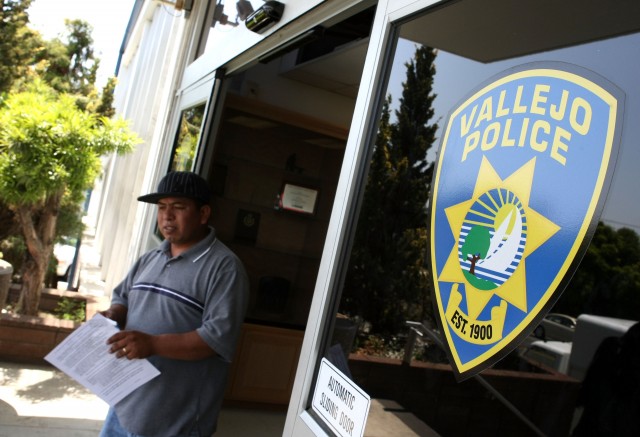Neighbor Marvin Clouse, who videotaped much of the incident, told KQED he rushed inside to call the fire department when he heard the men talk about starting to set their house on fire.
Officers arrived at a darkened house with broken windows and an open front door, according to the letter. Kenney and Sgt. Brett Clark approached the darkened front door with flashlights, and Clark was carrying a "37 mm less-lethal munitions gun," a launcher that can fire impact rounds like rubber bullets. The letter says an off-duty officer who was riding along with Kenney shouted "'he's got a gun,' or something similar."
Clark, at the front door, called for people inside the house to come out as Kenney covered him from the side. One of the naked men complied and got on the ground, but as Kenney reached for his handcuffs, he saw the barrel of a rifle but not who was holding it, according to the letter.
"He yelled commands and fired several shots where he believed the subject with the rifle would be standing," the summary says. After the first barrage of gunshots, both men were lying on the ground and officers commanded them to show their hands.
"The first white male complied; however, the second male was seen reaching for the rifle," the letter says. "The second male did not comply with the commands that Officer Kenney was giving, so Officer Kenney fired his weapon two more times."
Oakland-based civil rights attorney Michael Haddad, who is representing Jeremiah Moore's parents in a federal wrongful death lawsuit against the city, says the district attorney's review does not affect the lawsuit.
"It doesn’t even make sense," Haddad said, "and it conflicts with the press release initially offered by the Vallejo Police Department."
The department initially reported that a man with a rifle appeared and "placed the barrel of the rifle directly against an officer's stomach." Another officer "immediately discharged his firearm at the man with the rifle. The man with the rifle fell to the floor and was taken into custody," the initial police statement says.
"They don’t mention the final two shots that now the DA report talks about," Haddad said.
Neighbor Marvin Clouse's camera did not capture much visually about the incident, but listen below to the audio of the first round of gunshots followed several seconds later by two final shots. This audio is graphic. KQED has made no internal edits to the sound clip.
Haddad said the evolving narrative about the incident piques his interest in Jeremiah Moore's autopsy, which has remained sealed by Vallejo police. A representative for the Solano County coroner confirmed Moore's autopsy remains "protected" by order of the Vallejo Police Department, despite the conclusion of the district attorney's investigation.
Vallejo police did not return calls inquiring about the status of the coroner's report and seeking an explanation of the protocol for the presence of an off-duty "ride along" officer who it appears was from another Bay Area police department, which also did not return calls seeking confirmation.
The district attorney's summary also seems to contradict statements from Jaime Alvarado, a witness who says he watched the scene play out from his upstairs window across the street.
Alvarado told KQED that an officer at the base of the steps to the home fired several shots at a naked man with his hands up standing in the doorway. Alvarado estimated the officer was 8-10 feet away from the man when he fired.
Haddad said the district attorney's conclusions don't change anything about the Moores' lawsuit.
"Even though the DA won't hold officers accountable, we can," Haddad said.
The investigation was completed during a lame-duck period for outgoing Solano District Attorney Don du Bain. He was unseated in the June primary election by Krishna Abrams, a top prosecutor within the office who campaigned on strong support from county law enforcement agencies and attorneys. She criticized ethics within the office following a controversy involving prosecutors, police and the former county medical examiner. Abrams is scheduled to take office Jan. 5, 2015.
